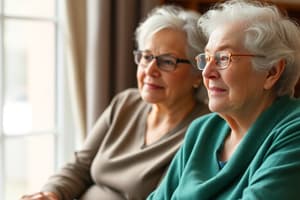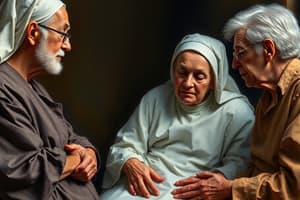Podcast
Questions and Answers
What significant milestone in geriatric nursing occurred in 1950?
What significant milestone in geriatric nursing occurred in 1950?
- Recognition of geriatric nursing as a specialization
- First publication of a nursing journal dedicated to geriatric care
- First geriatric nursing master's program launched
- First geriatric nursing textbook was published (correct)
Which nursing organization recommended the formation of a specialty group for geriatric nurses in 1961?
Which nursing organization recommended the formation of a specialty group for geriatric nurses in 1961?
- Nursing Research Council
- International Gerontology Federation
- American Nurses Association (ANA) (correct)
- National Nursing Association
What year did the first journal specifically for the care of older adults get published?
What year did the first journal specifically for the care of older adults get published?
- 1980
- 1970
- 1985
- 1975 (correct)
Who was the first nurse to present at the International Congress of Gerontology in 1968?
Who was the first nurse to present at the International Congress of Gerontology in 1968?
What does the term gerontology refer to?
What does the term gerontology refer to?
In what year was the first PhD program in gerontological nursing established?
In what year was the first PhD program in gerontological nursing established?
What age group is referred to as 'young old' in gerontological studies?
What age group is referred to as 'young old' in gerontological studies?
Which term describes the fear of aging?
Which term describes the fear of aging?
What term specifically refers to medical care for aging individuals?
What term specifically refers to medical care for aging individuals?
At what percentage is it expected that persons 65 and older will represent in the U.S. population by 2025?
At what percentage is it expected that persons 65 and older will represent in the U.S. population by 2025?
Which of the following terms refers to emotional prejudice against older adults?
Which of the following terms refers to emotional prejudice against older adults?
What phenomenon describes the demographic trend of an increasing aged population in the U.S.?
What phenomenon describes the demographic trend of an increasing aged population in the U.S.?
Which age group was projected to reach approximately 33 million by 2030 in the U.S.?
Which age group was projected to reach approximately 33 million by 2030 in the U.S.?
What percentage of the U.S. population was over age 60 in 2005?
What percentage of the U.S. population was over age 60 in 2005?
In the mid-21st century, what significant demographic change regarding age is predicted?
In the mid-21st century, what significant demographic change regarding age is predicted?
Which of the following challenges is particularly faced by developing Asian countries regarding aging populations?
Which of the following challenges is particularly faced by developing Asian countries regarding aging populations?
What percentage of older adults report a chronic disability?
What percentage of older adults report a chronic disability?
Which factor does NOT positively affect life expectancy?
Which factor does NOT positively affect life expectancy?
What is the average life expectancy of women in the United States?
What is the average life expectancy of women in the United States?
Which of these groups is predominantly composed of centenarians?
Which of these groups is predominantly composed of centenarians?
What proportion of older adults has at least one chronic condition?
What proportion of older adults has at least one chronic condition?
Which of the following is a leading cause of death among older adults?
Which of the following is a leading cause of death among older adults?
What impact does male exposure to risk factors have on life expectancy?
What impact does male exposure to risk factors have on life expectancy?
What has contributed to the decline in overall deaths over the past 50 years?
What has contributed to the decline in overall deaths over the past 50 years?
What is the primary factor contributing to the decline in limitations of activities among older adults?
What is the primary factor contributing to the decline in limitations of activities among older adults?
Which of the following psychosocial theories of aging suggests that remaining active is essential for satisfaction in later life?
Which of the following psychosocial theories of aging suggests that remaining active is essential for satisfaction in later life?
What percentage of the total population in the Philippines is projected to be made up of older individuals by 2030?
What percentage of the total population in the Philippines is projected to be made up of older individuals by 2030?
Which health-related problem is NOT mentioned as common among older adults?
Which health-related problem is NOT mentioned as common among older adults?
What is one potential consequence of the rising population of older adults in the Philippines?
What is one potential consequence of the rising population of older adults in the Philippines?
According to the theories of aging, what is the main purpose of the Disengagement Theory?
According to the theories of aging, what is the main purpose of the Disengagement Theory?
What common health issue arises from the ageing of the body’s immune system?
What common health issue arises from the ageing of the body’s immune system?
What proportion of the population aged 60 and above in the Philippines is represented by older women?
What proportion of the population aged 60 and above in the Philippines is represented by older women?
What was the general view of older adults in early Egyptian society?
What was the general view of older adults in early Egyptian society?
Which philosopher supported the idea of older adults as society's best leaders?
Which philosopher supported the idea of older adults as society's best leaders?
During which historical period did feelings of youth superiority prominently rise?
During which historical period did feelings of youth superiority prominently rise?
What kind of laws did England develop in the early 17th century to support older adults?
What kind of laws did England develop in the early 17th century to support older adults?
What is attributed to the development of gerontological nursing as a specialty?
What is attributed to the development of gerontological nursing as a specialty?
Why is there a growing need for gerontological nursing today?
Why is there a growing need for gerontological nursing today?
How did nursing pioneers Florence Nightingale and Doreen Norton contribute to gerontological nursing?
How did nursing pioneers Florence Nightingale and Doreen Norton contribute to gerontological nursing?
What was the societal attitude towards the sick and aged in the nations conquered by the Roman Empire?
What was the societal attitude towards the sick and aged in the nations conquered by the Roman Empire?
Flashcards are hidden until you start studying
Study Notes
Historical Perspectives on Aging
- Older adults are now viewed positively, compared to previous prejudiced views.
- In Confucian times, age correlated with respect; early Egyptians feared aging, seeking potions for youth.
- Ancient Greeks had mixed opinions: Plato admired older adults as leaders, while Aristotle excluded them from politics.
- Roman Empire typically saw the sick and aged as expendable.
- Biblical texts, such as Exodus, emphasize respect for elders.
- The Middle Ages prioritized youth, leading to conflicts between generations.
- In the 17th century, England's Poor Laws provided limited support for the elderly, which eroded during the Industrial Revolution due to lack of labor protections.
Development of Gerontological Nursing
- Gerontological nursing encompasses diverse experiences catering to the aging population.
- Increasing life expectancy means nurses will frequently care for older adults in their careers.
- Pioneering figures include Florence Nightingale and Doreen Norton, who focused on unique elder needs.
- Landmark events in gerontological nursing:
- 1902: First geriatric article published in American Journal of Nursing.
- 1950: First geriatric nursing textbook published.
- 1966: Establishment of the first master's program at Duke University.
- 1975: Launch of the Journal of Gerontological Nursing.
- 1989: Certification established for Clinical Specialists in Gerontological nursing.
Understanding Gerontology and Geriatrics
- Gerontology is the study of aging; "Gero" means old age, "ology" means study.
- Categories of older adults:
- Young old: 65-74 years
- Middle old: 75-84 years
- Old old: 85 years and older
- Gerontophobia, age discrimination, and ageism describe societal prejudices against older adults.
- Geriatrics focuses on medical care for the elderly, while gerontological nursing addresses nursing practice related to aging.
Demographics of Aging
- The "Graying of America" reflects a global aging phenomenon.
- By 2025, older adults (65+) will constitute 19% of the U.S. population.
- In 2005, 13% of the U.S. population was over age 60; projections show significant growth to nearly 50 million by 2050.
- Developing countries face rapid aging, struggling with inadequate healthcare systems.
Factors Influencing Aging
- Modern older adults demand quality long-term care, including technology access and fitness amenities.
- Life expectancy in the U.S.: 75.7 years; potential maximum lifespan: 115 years.
- Notable life expectancy influencers: sanitation, medical advances, and preventive health services.
- Centenarians often have fewer chronic conditions and medications.
Feminization of Later Life
- Women represent 55% of the older population and have a longer average life expectancy (81 years) than men (75.2 years).
- Gender differences in life expectancy linked to male risk factor exposure.
Chronic Conditions and Health Trends
- 80% of seniors report at least one chronic condition.
- Heart disease and cancer account for the majority of deaths among those 65+.
- A decline in mortality rates due to improved healthcare and early disease detection.
Aging Population in the Philippines
- Rapid growth of the elderly population from 4.6 million in 2000 to an expected 23.6 million by 2050.
- Common health issues include infections, visual impairment, arthritis, and incontinence.
- Average life expectancy in the Philippines: 66 years for males, 73 years for females.
Psychosocial Theories of Aging
- Psychosocial theories discuss behavioral and personality changes in aging.
- Activity Theory posits that engagement is crucial for satisfaction in later life.
- Disengagement Theory suggests that gradual withdrawal helps maintain social balance and encourages reflection.
Studying That Suits You
Use AI to generate personalized quizzes and flashcards to suit your learning preferences.




